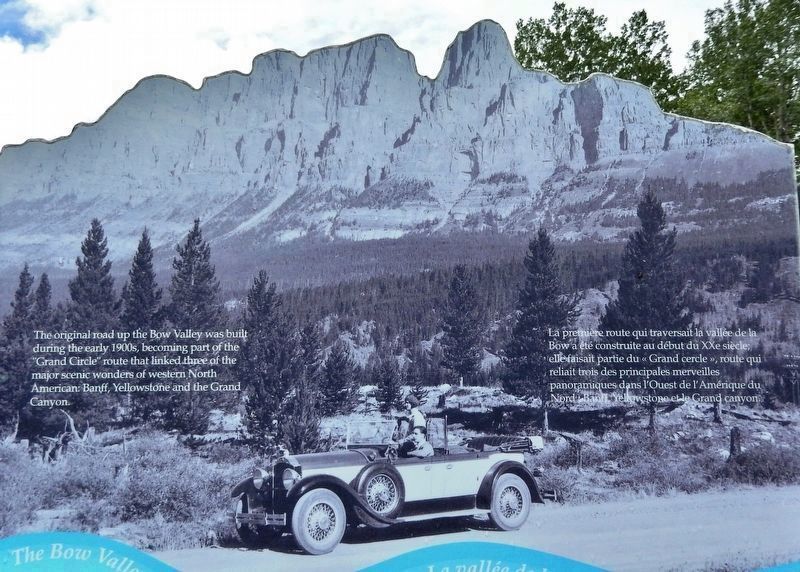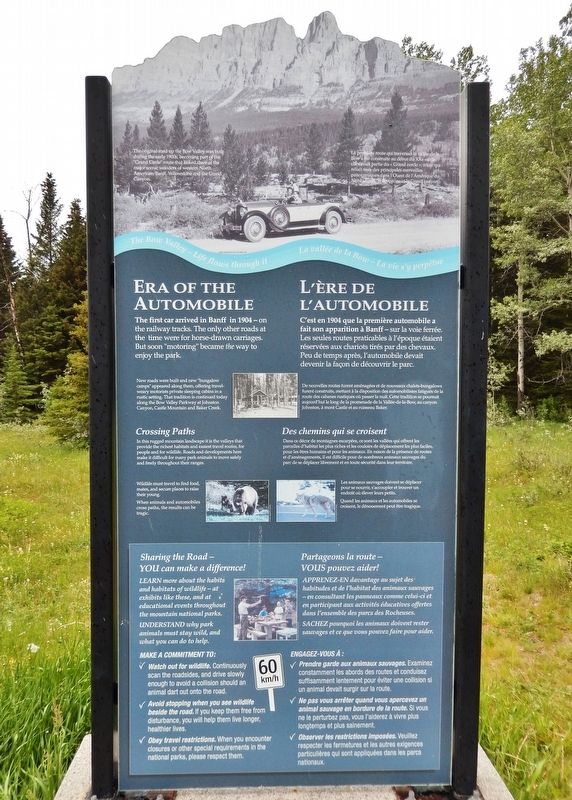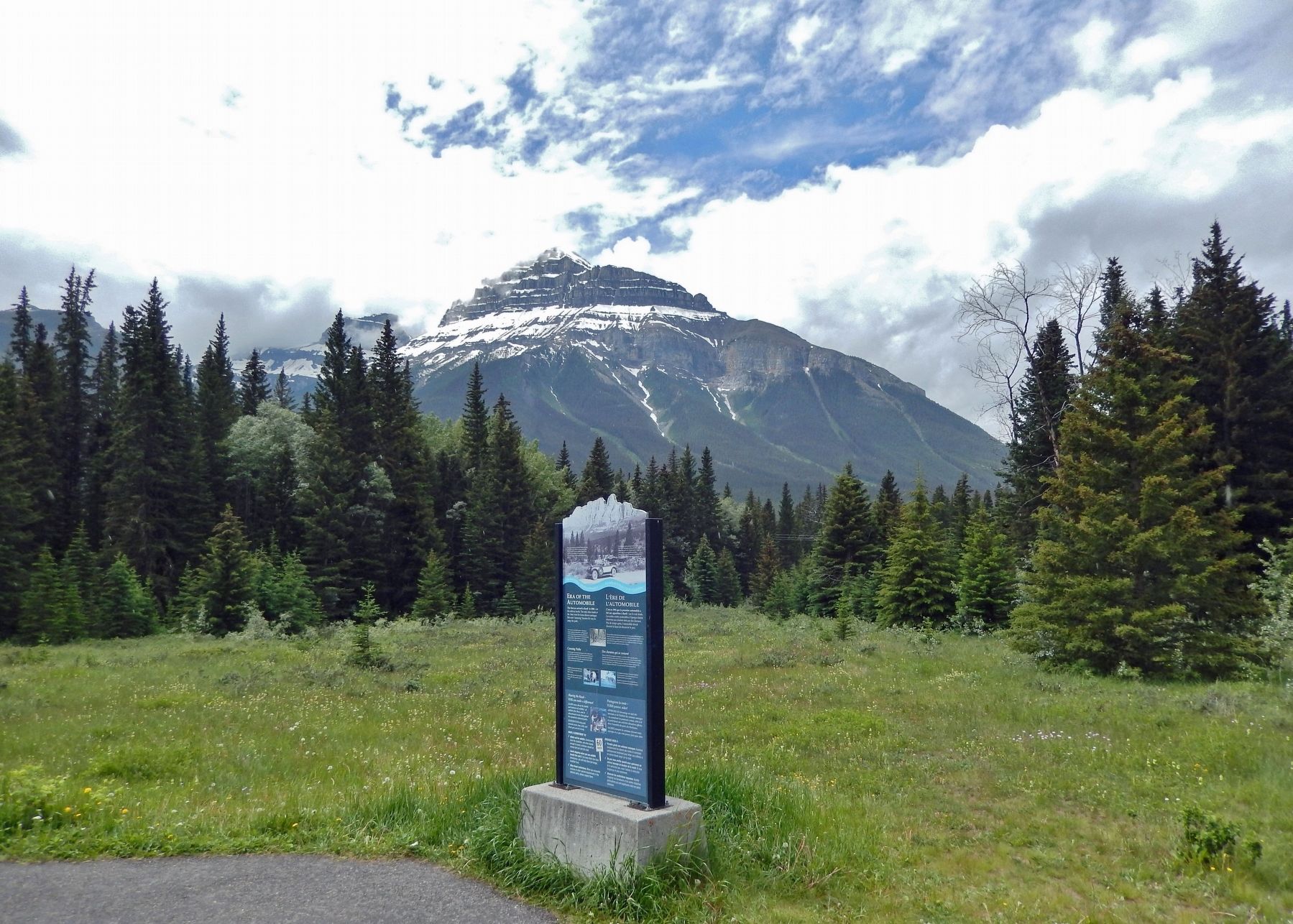Near Massive in Banff National Park, Alberta — Canada’s Prairie Region (North America)
Era of the Automobile / L'ère de l'automobile
The Bow Valley — Life flows through it
The first car arrived in Banff in 1904 - on the railway tracks. The only other roads at the time were for horse-drawn carriages. But soon "motoring" became the way to enjoy the park.
New roads were built and new "bungalow camps" appeared along them, offering travel-weary motorists private sleeping cabins in a rustic setting. That tradition is continued today along the Bow Valley Parkway at Johnston Canyon, Castle Mountain and Baker Creek.
Crossing Paths
In this rugged mountain landscape it is the valleys that provide the richest habitats and easiest travel routes, for people and for wildlife. Roads and developments here make it difficult for many park animals to move safely and freely throughout their ranges.
Wildlife must travel to find food, mates, and secure places to raise their young. When animals and automobiles cross paths, the results can be tragic.
Sharing the Road — YOU can make a difference!
LEARN more about the habits and habitats of wildlife — at exhibits like these, and at educational events throughout the mountain national parks.
UNDERSTAND why park animals must stay wild, and what you can do to help.
MAKE A COMMITMENT TO:
✓ Watch out for wildlife. Continuously scan the roadsides, and drive slowly enough to avoid a collision should an animal dart out onto the road.
✓ Avoid stopping when you see wildlife beside the road. If you keep them free from disturbance, you will help them live longer, healthier lives.
✓ Obey travel restrictions. When you encounter closures or other special requirements in the national parks, please respect them.
La vallée de la Bow — La vie s’y perpétue
C'est en 1904 que la première automobile a fait son apparition à Banff — sur la voie ferrée. Les seules routes praticables à l'époque étaient réservées aux chariots tirés par des chevaux. Peu de temps après, l'automobile devait devenir la façon de découvrir le parc.
De nouvelles routes furent aménagées et de nouveaux chalets-bungalows furent construits, mettant à la disposition des automobilistes fatigués de la route des cabanes rustiques où passer la nuit. Cette tradition se poursuit aujourd'hui le long de la promenade de la Vallée-de-la-Bow, au canyon Johnston, à mont Castle et au ruisseau Baker.
Des

Glenbow Archives NA-4868-106
2. Marker detail: Original Road / La première route
The original road up the Bow Valley was built during the early 1900s, becoming part of the "Grand Circle" route that linked three of the major scenic wonders of western North America: Banff, Yellowstone and the Grand Canyon.——— La première route qui traversait la vallée de la Bow à été construite au début du XXe siècle; elle faisait partie du « Grand cercle », route qui reliait trois des principales merveilles panoramiques dans l'Ouest de l'Amérique du Nord : Banff, Yellowstone et le Grand canyon.
Dans ce décor de montagnes escarpées, ce sont les vallées qui offrent les parcelles d'habitat les plus riches et les couloirs de déplacement les plus faciles, pour les êtres humains et pour les animaux. En raison de la présence de routes et d'aménagements, il est difficile pour de nombreux animaux sauvages du parc de se déplacer librement et en toute sécurité dans leur territoire.
Les animaux sauvages doivent se déplacer pour se nourrir, s'accoupler et trouver un endroit où élever leurs petits. Quand les animaux et les automobiles se croisent, le dénouement peut être tragique.
Partageons la route — VOUS pouvez aider!
APPRENEZ-EN davantage au sujet des habitudes et de l'habitat des animaux sauvages — en consultant les panneaux comme celui-ci et en participant aux activités éducatives offertes dans l'ensemble des parcs des Rocheuses.
SACHEZ pourquoi les animaux doivent rester sauvages et ce que vous pouvez faire pour aider.
ENGAGEZ-VOUS À :
✓ Prendre garde aux animaux sauvages. Examinez constamment les abords des routes et conduisez suffisamment lentement pour éviter une collision si un animal devait surgir sur la route.
✓ Ne pas vous arrêter quand vous apercevez un animal sauvage en bordure de la route. Si vous ne le perturbez pas, vous l'aiderez à vivre plus longtemps et plus
sainement.
✓ Observer les restrictions imposées. Veuillez respecter les fermetures et les autres exigences particulières qui sont appliquées dans les parcs nationaux.
Topics. This historical marker is listed in these topic lists: Animals • Parks & Recreational Areas • Roads & Vehicles. A significant historical year for this entry is 1904.
Location. 51° 13.392′ N, 115° 47.011′ W. Marker is near Massive, Alberta, in Banff National Park. Marker is on Bow Valley Parkway (Provincial Highway 1A) 11 kilometers east of Banff-Windermere Highway (Provincial Highway 93), on the left when traveling east. Marker is located in a pull-out on the north side of the parkway. Touch for map. Marker is in this post office area: Massive AB T0L T0L, Canada. Touch for directions.
Other nearby markers. At least 4 other markers are within 16 kilometers of this marker, measured as the crow flies. Storm Mountain (approx. 13 kilometers away); The Cave and Basin (approx. 14.8 kilometers away); Castle Mountain Internment Camp (approx. 14.9 kilometers away); Castle Camp (approx. 14.9 kilometers away).
Credits. This page was last revised on December 18, 2022. It was originally submitted on December 17, 2022, by Cosmos Mariner of Cape Canaveral, Florida. This page has been viewed 96 times since then and 10 times this year. Photos: 1, 2, 3. submitted on December 17, 2022, by Cosmos Mariner of Cape Canaveral, Florida.

